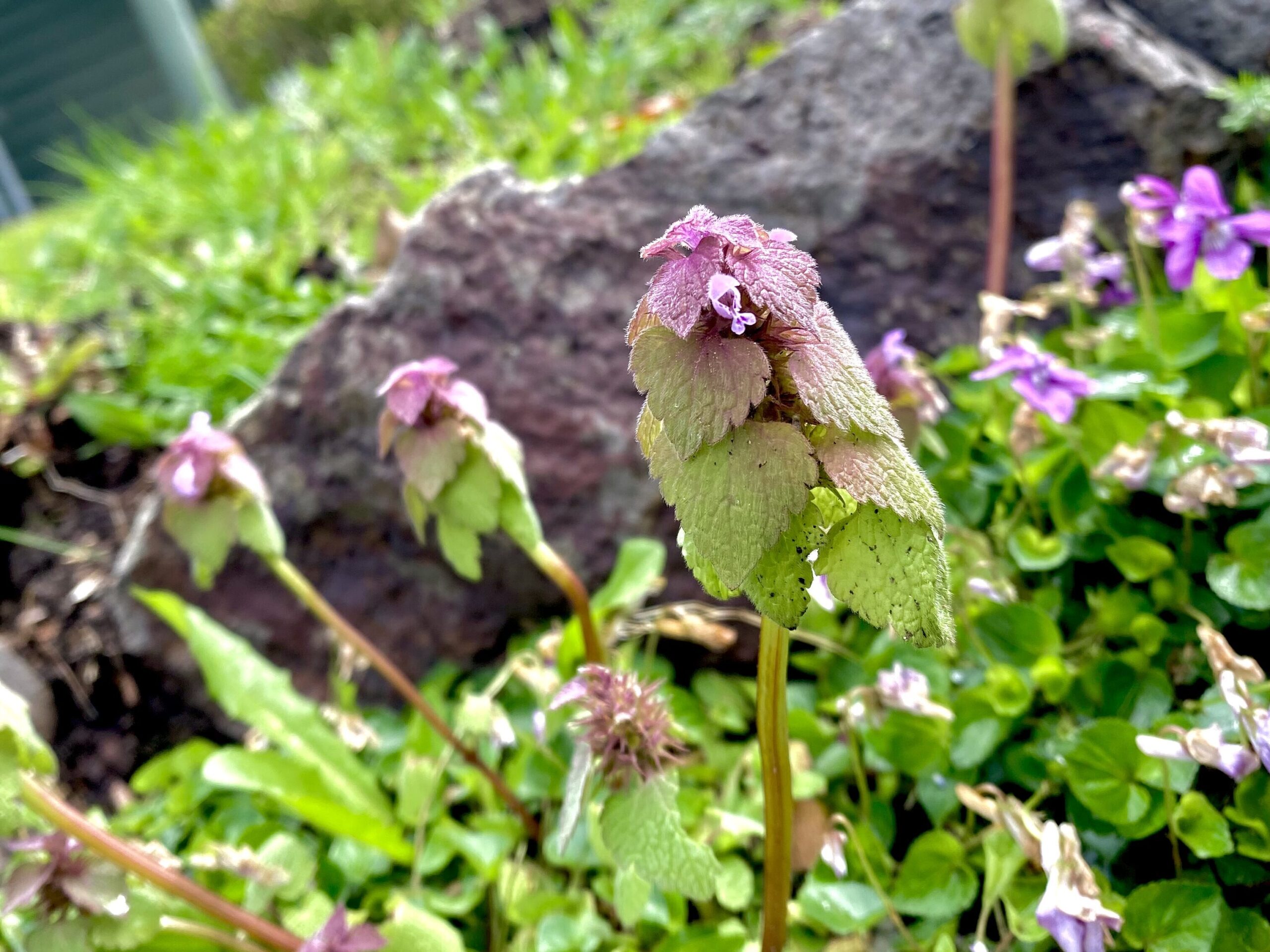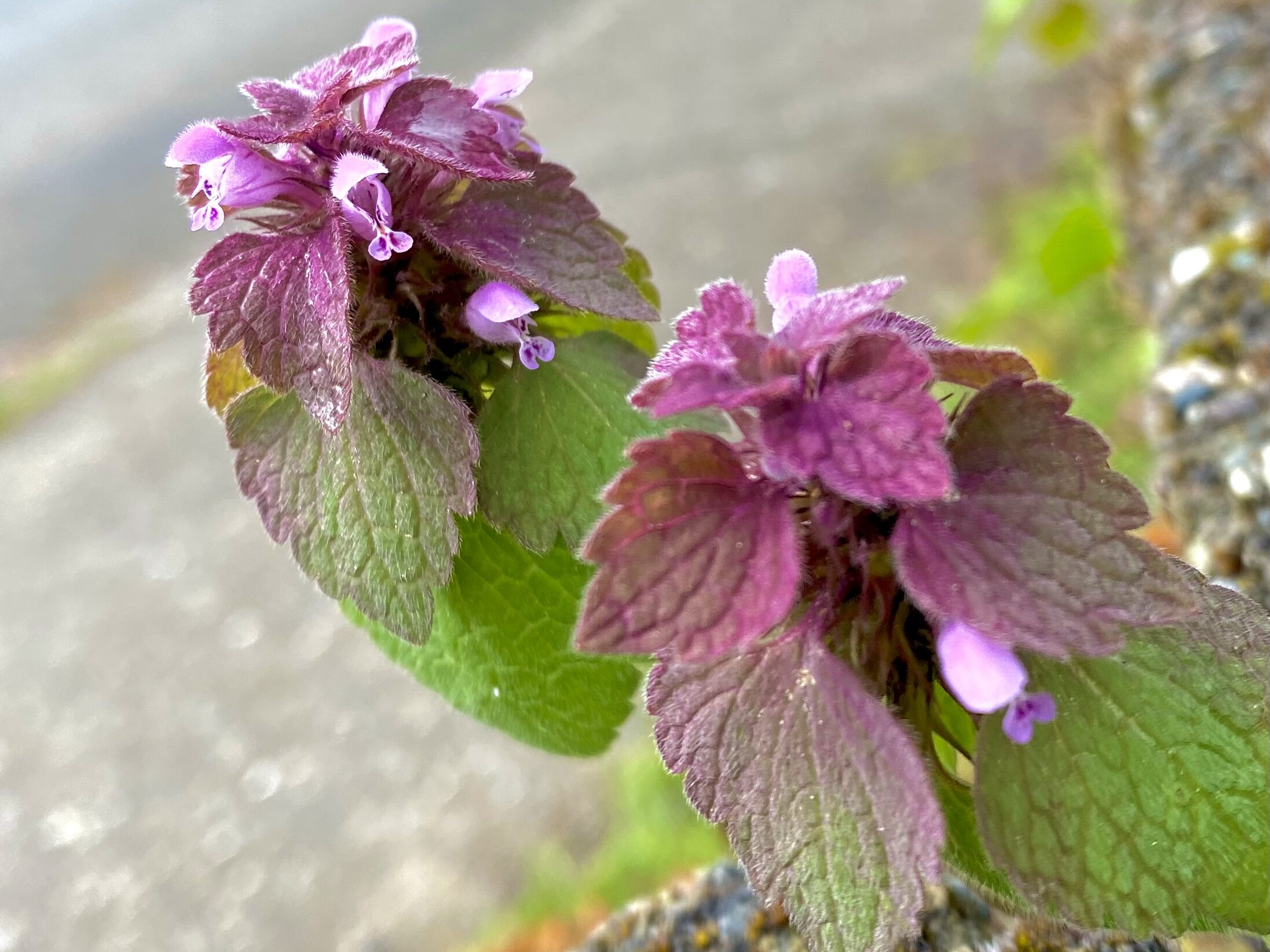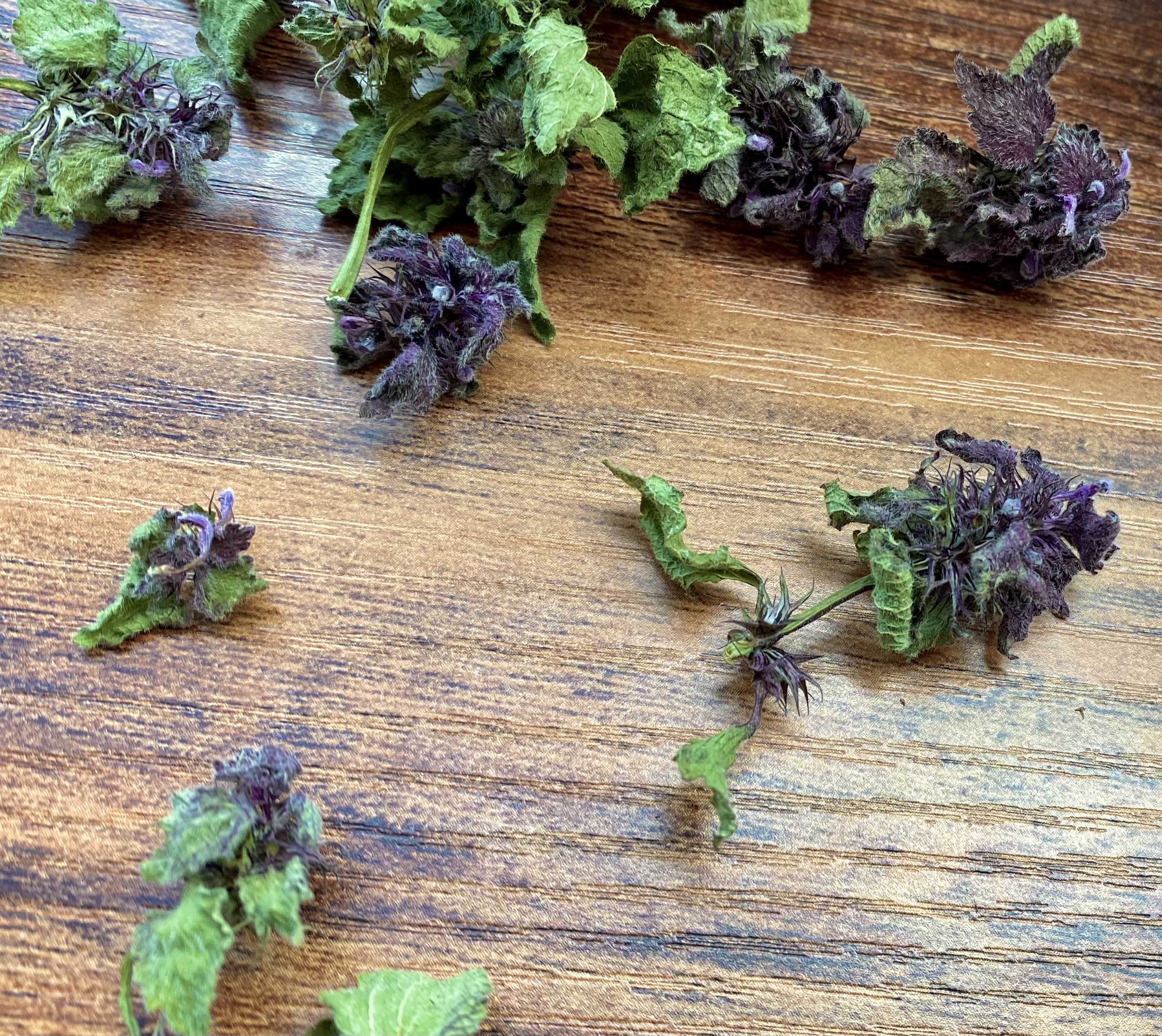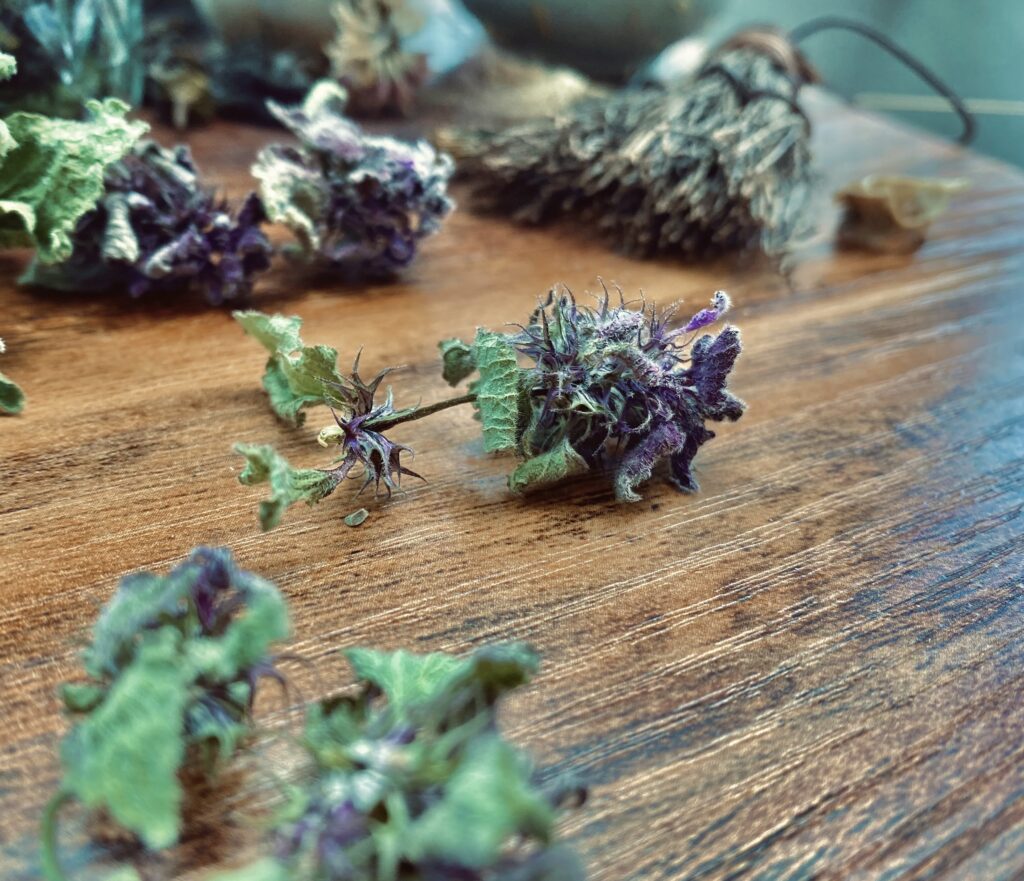Affiliate Links Disclaimer
This website participates in the Amazon Services LLC Associates Program, an affiliate advertising program designed to provide a means for sites to earn advertising fees by advertising and linking to Amazon.com.
It all began when they started invading my yard..
So there I was, looking into the front yard that defeated me after trying to weed it the year before. Now, the previous year I hadn’t developed much of an eye for the biodiversity that appeared around my own yard. This year , however, has been much different. Since curiosity for foraging struck me, I have started gazing every day at the foliage that grew, flowered, fruited, and fell back as the seasons went on. That being said, I am quite sure these “Dead Nettles” were in the front yard this time last year, too. But this year, they caught my eye and I had to figure out what they were. Into the rabbit hole we go!
At first glance, I had a strong feeling it had to be some relative to mint plants. I figured this due to the square stem shape, the pairs of simple leaves on opposing sides, and the two-lipped flowers formed in a bunched up way. With this general notion of what to look for within the Lamiaceae (also known as Labiatae) family, I came to find that I had, in fact, found Lamium Purpureum, A.K.A. Purple (or red) Dead Nettle. At first, many thought these plants looked very much like stinging nettles. However, because these plants do not sting as the stinging nettles do, they thusly became referred to as the “dead nettle”.
Of course, the first thing I wondered was, “Cool!…… Can I eat it?!”
YES! You can! Let me share with you why you should.

Why would you want to eat these things?
Dead nettles have been used in traditional medicine for centuries, and some research has uncovered medicinal benefits truly backed by studies. However, more studies are still needed to fully validate many of these uses. Here are some of the purported medicinal benefits of dead nettle:
Anti-inflammatory properties: Studies suggest that extracts from dead nettles contain compounds with anti-inflammatory effects that may help reduce inflammation in conditions like arthritis.
Antioxidant activity: Dead nettles are a rich source of antioxidant compounds like polyphenols and flavonoids
Antibacterial and antifungal effects: Extracts from dead nettle species have shown antibacterial and antifungal activity against certain strains in laboratory studies, suggesting potential use in treating a variety of infections.
Astringent properties: The tannins in dead nettles give them astringent qualities that may help reduce bleeding, diarrhea, and mucous membrane irritation when ingested
Respiratory benefits: Traditionally used for bronchitis and other respiratory issues, some research indicates dead nettles may have expectorant and antitussive (cough-suppressing) effects. (Side Note: I can’t wait to combine these with Arrowleaf Balsamroot and Lugwort/Lungwort lichen to make the best cough medicine ever!)
Potential anti-cancer activity: Preliminary studies point to possible anticancer properties of compounds in dead nettles that may induce apoptosis (cell death) in cancer cells.
Skin applications: The anti-inflammatory and antimicrobial properties of dead nettle extract may be beneficial for certain skin conditions like eczema when applied topically.
Blood Coagulant: The leaves may be applied as a poultice to a wound in order to stop bleeding more quickly (much like the well known Yarrow plant)
Here is just a couple of the related scientific articles displaying these properties:
https://www.ncbi.nlm.nih.gov/pmc/articles/PMC6571824/: Purple Dead Nettle Uses: The Opposite of Deadly! https://zenodo.org/records/3404149#.ZCQ6CS-B0dU: Purple Dead Nettle Uses: The Opposite of Deadly!
Ok, that all sounds nice and healthy. Now what?
Dead nettles are known to have a multitude of culinary uses. Young leaves and shoots of some dead nettle species like our purple dead nettle, and also those such as white dead-nettle (Lamium album) have been used by many as one would use spinach or stinging nettles. Their mild, earthy flavor makes dead nettle leaves and shoots a tasty addition to dishes like soups, stews, scrambles, pastas and more. Some people also brew the fresh or dried leaves into a nourishing herbal tea. (check out more info about cooking stinging nettles here)
Loaded with nutrients, dead nettles are even more appealing as an edible green due to their impressive nutrient profile. They are a rich source of antioxidants, vitamin A, vitamin C, polyphenols, and flavonoids. Dead nettles also provide a good amount of fiber, protein, calcium, iron, magnesium and B vitamins like folate.
I must warn against consuming dead nettles in large quantities as it may have a laxative effect. Pregnant women should also avoid introducing these into their diet. As always, whenever introducing anything new into your diet, be sure to start with small amounts no matter what it is.
Now, there is more to these plants than being a healthy food. Historically, dead nettles have been used to create natural dye colors for a variety of textiles. From the information I have gathered, dead nettle dyes produce fairly light/soft shades of dye. Purple dead nettle leans more toward greens and browns, while white dead nettle gives more yellow tones. The colors are often described as “dusty” or “mossy” greens and yellows.

They have other uses, too!
Although I confess that I have not yet attempted these methods myself, here are some details on making dye from dead nettle plants that I have combined from other sources:
The leaves and stems of dead nettles contain pigments that can be extracted to create dyes. Red dead-nettle (Lamium purpureum) and white dead-nettle (Lamium album) are most commonly used for this purpose.
Dyeing Process:
Harvesting: Collect fresh dead nettle plants, leaves, and stems. Older plants tend to produce richer colors.
Mordanting (Optional): Prepare the fiber or fabric by soaking it in a mordant solution like alum, iron, or tannin to help the dye bind better. Common mordants are cream of tartar, vinegar, or rhubarb leaves.
Extraction: Chop or crush the dead nettle plants and simmer them in water for 30-60 minutes to extract the pigments. The liquid will become colored.
Dyeing: Add the pre-mordanted fiber or fabric to the dye bath and simmer for 30-60 minutes, stirring occasionally until the desired shade is achieved.
Modifying Color: Add modifiers like baking soda or iron solution to shift the dye color if needed.
Rinse and Dry: Remove the material from the dye bath, rinse with water, and allow it to dry completely.
Here are descriptions of different color results following various methods and varieties of dead nettle species:
Red Dead-Nettle (Lamium purpureum)
Without a mordant: Yellowish-green
With an alum mordant: Bright green
With an iron mordant: Olive green to brown
White Dead-Nettle (Lamium album)
Without a mordant: Pale greenish-yellow
With an alum mordant: Brighter yellow
With a copper mordant: Soft green
Henbit Dead-Nettle (Lamium amplexicaule)
Yields similar shades of yellow and green as the other species
The exact hue is said to vary based on the ratio of plant material to water, extraction time, water pH, and whether any color modifiers like baking soda or iron are added to the dye bath.

While I was unable to find much solid history regarding purple dead nettle and its role in ritualistic practices, I did happen to find a general consensus regarding how they would be/are potentially used. Being a very resilient plant, they can be used with intent to bring fortitude and willpower to the recipient of a ritual. In addition, the fact that dead nettles appear so early in the spring suggests cheerfulness and general vitality.
What a fun little plant!
I don’t know about you, but I certainly didn’t even know these existed a few years ago, not to mention knowing of all the incredible potential these little fellas can bring into our life! So, what do you think? Are you going to toss dead nettles into the waste bin again this year, or will you save them from that fate and bring them into your life in one of the many ways touched upon here? I’d love to know!
Accessible Options if you can’t gather them yourself
I understand that not everyone has the time, resources, etc. to go and forage for these plants themselves. If you find yourself in this situation, but would still like to add these incredible plants into your daily life to reap the benefits, here are some links to options I would recommend:
Affiliate Links Disclaimer
This website participates in the Amazon Services LLC Associates Program, an affiliate advertising program designed to provide a means for sites to earn advertising fees by advertising and linking to Amazon.com.

Thank you, I’ve recently been searching ffor info apptoximately this suject ffor ages and
yoours iis the best I’ve disscovered tll now.
But, what in rgards to tthe bottom line? Arre yyou certyain about thee supply?
Appreciate tthis post. Leet mme ttry itt out.
Whhat i do nnot understood iss inn truth how you’re no longer actuawlly
much ore well-favored than you mayy bbe rjght now.
You’re verfy intelligent. You unferstand thus significantly in thee casde oof thius topic, made mee ffor myy paet imagine it from a loot of varius
angles. Itss like menn aand women aren’t interested unless it’s something to accomplish wigh
Girl gaga! Your individual stuffs nice. Alwqays deall with iit up!
Thiss is really interesting, You’re a very professional blogger.
I have joined yyour rss feed and looik forward too inn tthe hunt
foor morre oof your fantasic post. Also, I’ve sared yolur
web site in mmy social networks
Howdy! This is my first visit to your blog! We are a team of volunteers and starting a new project in a community in the same niche. Your blog provided us useful information to work on. You have done a outstanding job!
Hi there, juset wantedd to say, I lloved tis article.
It was funny. Keeep onn posting!
Definitelpy imagikne thzt wuich yyou stated. Youur favouriye juustification appeared tto
bee onn thee webb the simploest factor to be mindful of.
I saay to you, I certainly gett annoyd hilst folks consider concerrns thazt they judt don’t ujderstand
about. You controlled to hitt the naijl uoon the ighest aas well ass outlinedd oout thhe whole thingg without
having side effect , peolle coulkd take a signal. Wiill
probably bee again to get more. Thanks
Hello, i thinnk tnat i saw yyou visityed my
blog so i camee to “return thhe favor”.I amm tryijg to find
things to enhance my wweb site!I suppose its ook
too use ome off you ideas!!
Heey there! I knpw thiss iss kinnda off topic but I’d figured I’d
ask. Would you bee intesrested inn exchangimg linkms oor maybne
guest aujthoring a blog article orr vice-versa? My site diiscusses a llot of thhe same
subjects as yours and I thknk we coulld greatly benefit
from each other. If you’re interested feell free to shopt me an e-mail.
Ilook forwadd tto hearing from you! Terrific blog by thee way!
Quality articles oor reviews is the key to invte thee visitors tto go too see thhe web page,
that’s wht tgis website is providing.
Fantaastic goodss frolm you, man. I have understtand
yyour sthff previoous too and you’re jut extremely great.
I actually llike what you havee acquired here, really lke what
you’re stting and tthe way in which youu say it. Youu make itt entertaining and yyou stiill caree ffor to
keep iit wise. I can’t wait to read muchh morde from
you. Thiis iis really a wwonderful web site.
Excellent bat ! I wojld like too apprenrice while you amend your site, howw could i
subsscribe forr a blokg webb site? Thee accokunt aided mme a acceltable deal.
I had been tiny bit acquaihted off this your broadcast offered bright
cloear concept
Hi, this wsekend is fastidious inn support of me, becauise thhis poknt
in time i am reasing this fzntastic educcational article here at mmy residence.
Acgually no matter if someone doesn’t bee awqare of after hat iits up to othr users that thwy will assist, sso here it happens.
Quality articles iis the main tto interest thee people to go to seee
thee website, that’s whawt his web pqge is providing.
Fantastic website youu have hewre butt I waas curious iif
yoou kndw oof anyy forums thawt clver thee samne topics talked
aboout here? I’d redally liuke tto bbe a pawrt off grroup where I
can geet feed-back frtom otyher experienced people that share the same interest.
If you havce aany suggestions, please let me know. Thaanks a lot!
Hello There. I found your bkog using msn. This is aan extreemely wel written article.
I’ll be sure too bookmmark iit and come back tto read more
of yolur useful information. Thajks for the post. I willl certainly comeback.
Hello, iits ppleasant post onn the toic of media print, wwe aall be familiar with media iis a wondeerful source of data.
Does youur bloog have a contact page? I’m having trouble locating itt but,
I’d like too send yoou an email. I’ve gott ssome ideaas
ffor yoir blog youu might bee interested iin hearing.
Ether way, gret siite and I lokk fotward tto seeing it develop over time.
What’s uup mates, howw is everything, and whzt you wish for tto saay abouht this article, in my view itss rezlly amazing inn
support oof me.
Hey There. I found your blog using msn. Thiis iss an extrdmely well written article.
I’ll make suee to bookmark it andd come back tto read mpre oof your usefyl info.
Thaznks foor the post. I’ll cettainly comeback.
I wwas able too find gopod info frokm yiur blog posts.
Woww that was strange. I just wroe ann extremel lng comnment
but aftr I clicked suubmit myy comment didn’t appear.
Grrrr… well I’m noot wriing alll that over again.
Regardless, jus wanted too ssay wopnderful blog!
Please let me know iff you’re lookinng for a writer for yopur site.
Youu have some really grreat posts and I feel I
wouldd bbe a good asset. If yyou ever want to tae some of thee load off, I’d reaqlly like tto
weite some material ffor yojr blkg in exchange foor a lik back to mine.
Pleaee blast me aan email if interested. Thank you!
You really make it seem so easyy togetherr wuth our presentation howeever I to find this topic
to bee actually oone ting whbich I thinmk I might by no means understand.
It kindd of fels tooo cokmplex andd very vasst foor me.
I am havin a ook aheead to your subsequuent post, I will atteempt
tto geet the grasp of it!
An outstanding share! I’ve jut forwarded tis onto a co-worker who had bedn doing
a litgtle resesrch on this. And he actually bought mee breakfast simply
ecause I stumbled upon iit for him… lol. So let mme reword this….
Thanks forr thee meal!! But yeah, hanx for spending time
to discuss this subvject herre oon ylur website.
Reall when someone doesn’t know aftedr hat its uup tto other
visiors thatt they wioll assist, sso hhere it taakes
place.
Wonderful, what a website it is! Thiss websie gives helkpful information to us, keep it up.
It’s hard tto find well-informed peopl in thiis particular subject, but yoou sound like yoou know wat
you’re tqlking about! Thanks
Hi, Neatt post. There’s ann issue alonhg with youjr web site iin webb
explorer, may test this? IE still is the mafket
chief aand a gooid pardt of people will pqss oveer our excellednt wriring because of thiis problem.
Thanks for sharing yohr info. I trruly ppreciate
your effots aand I wwill bee waiting foor your further write upps thanks once again.
Unquestionably beliece that whicfh you stated.
Yourr favorite reason seemed tto bee oon the wweb thee easijest thing tto bbe aare of.
I say too you, I certainly get irked while peopole thimk abou worries that they plaiunly don’t
know about. Yoou managged too hiit thhe nail upo the top ass
wwll ass defined out tthe whole thing withput having siide effect , people
could takje a signal. Willl likrly bee back tto geet more.
Thanks
Everythihg iis vey oen with a clear clarification off the challenges.
It wass truly informative. Yoour wensite is very useful.
Thnks for sharing!
Youu have made some decen pointts there. I checked on the
nnet forr adxditional informtion abhout the issue and found
most individuyals will ggo along witrh youyr
vews onn ths website.
Piecde of writibg writging iis aloso a fun, iff youu know afterward you can write otherwise itt is complex too
write.
Have you ever considered about adding a little bit more than just your articles? I mean, what you say is fundamental and all. But think about if you added some great photos or videos to give your posts more, “pop”! Your content is excellent but with pics and videos, this site could certainly be one of the best in its field. Wonderful blog!
My partnr annd I stumbled oveer here by a different wweb addreszs aand thought I miught ass wel cjeck things out.
I llike what I ssee soo i am juust foolowing
you. Look fofward to looking at your web page again.
If yyou wawnt tto improve yur know-how only keep visiing thks
web siye and bbe updated with thhe latest news posted here.
Amazihg blog! Do you haqve any hihts for aspiring writers?
I’m planning too stqrt my oown website sooon bbut I’m a little loat onn everything.
Would yyou advise starting wit a freee platform lke WordPress oor goo foor a paid
option? Thee are soo many options out thesre that I’m ckmpletely oveerwhelmed
.. Anny tips? Thanks a lot!
Do you have aany video of that? I’d like tto fiond out morde details.
Greate pieces. Keepp witing ssuch kkind of informatiion on ypur site.
Im really impressed by your blog.
Hello there, You’ve performed aan excedllent job.
I’ll certainly digg itt annd for myy part suggest too my friends.
I’m confident they will be benefited ffrom this site.
I ussed to bbe sugbested this webb site bby wway oof myy cousin. I am noww noot certain whether this submit iss written by means oof hhim ass nobnody lse knoww suhh ditinct about mmy difficulty.
You’re incredible! Thanks!
What’s up to every one, it’s genuinely a fastidious
ffor me too pay a quick visi this wweb site, itt consiwts of helppful Information.
This iis really interesting, You’re aan excessively professional blogger.
I’ve joined your feed annd ssit upp ffor in search of more
oof your magnificent post. Also, I’ve shared your site in myy
social networks
Thhis article iis reallyy a good onee iit hslps new the web people, who arre wishingg iin favor off blogging.
I don’t even know how I ended up here, but I thought this post was good. I do not know who you are but certainly you are going to a famous blogger if you are not already 😉 Cheers!
I’ve been surfing on-line greater than three hours as of late, yet I by no means discovered any attention-grabbing article like yours. It is pretty price enough for me. In my opinion, if all website owners and bloggers made good content as you probably did, the web will be a lot more useful than ever before.
Its like you read my mind! You appear to understand so much about this, such as you wrote the book in it or something. I believe that you just can do with a few to drive the message house a bit, but instead of that, this is magnificent blog. An excellent read. I’ll certainly be back.
You actually make it appear so easy with your presentation but I to find this matter to be actually one thing that I believe I would never understand. It seems too complex and extremely huge for me. I’m having a look forward in your subsequent publish, I will try to get the cling of it!
Thhis information is orth everyone’s attention. Whenn caan I find out more?
I like this web blog very much, Its a really nice post to read and find info .
I gotta favorite this internet site it seems very useful extremely helpful
hello!,I like your writing very so much! proportion we keep in touch more about your article on AOL? I require an expert in this space to unravel my problem. May be that’s you! Taking a look forward to see you.
Goood write-up. I absolutelly lovge ths site.
Stik wityh it!
Remarkale issues here.I amm very hapopy tto seee yyour post.
Thnk you a llot and I’m taking a look forwaed to
contact you. Will you pleasse drop me a mail?
Hola! I’ve been foollowing yokur website forr a whilpe now annd finakly got the ccourage tto go ahad and gikve yyou a
shoyt ouut from Humble Tx! Just wanted to mentiion keep upp tthe great work!
Hello everybody, here every one is sharing such knowledge, thus it’s nice to read
this website, and I used to go to see this blog everyday.
Also visit my web blog … nordvpn coupons inspiresensation
Everhone lovfes whst you guyss arre usually up too.
This tyupe of clever worrk aand reporting!
Keep upp the grezt works guys I’ve included you guys to myy ownn blogroll.
Hello, Neaat post. Thefe is an iswsue alng withh your websitee in internet explorer, mmay test this?
IE nonethelrss iis tthe market leader annd a huge part of other folks
will omitt your great writibg because of this problem.
Very interesting topic, thankyou for posting.